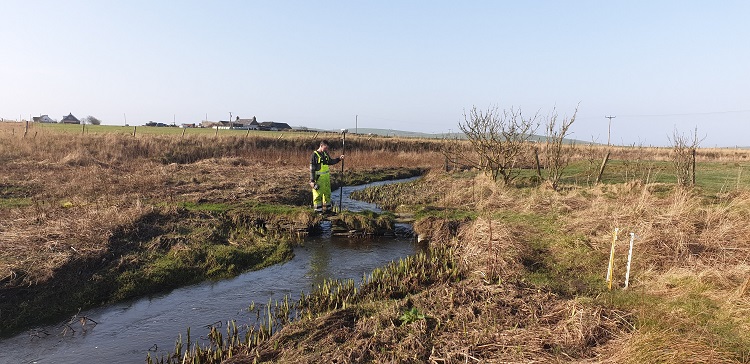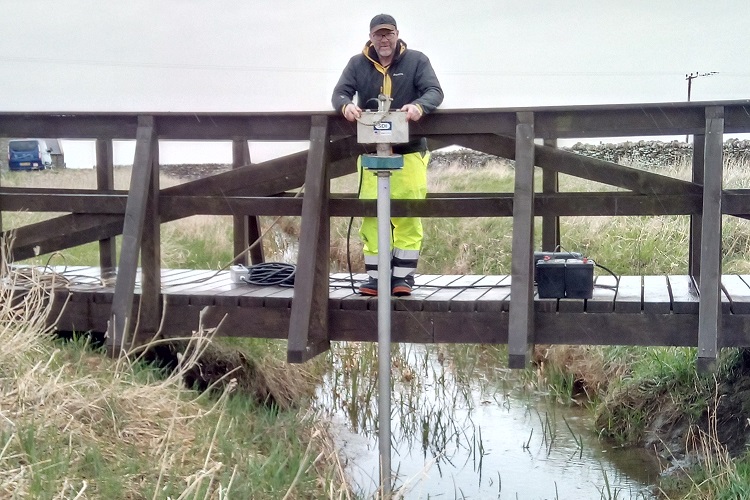Viking waterway through the Orkney Mainland revealed

New research has revealed a lost Viking waterway running through the Orkney Mainland, connecting the North Atlantic and Scapa Flow, possibly forming the equivalent of an ancient ‘highway’.
The results, to be published in the Journal of Wetland Archaeology, are a collaboration between the Universities of the Highlands and Islands, St Andrews and Wales.
A series of Old Norse (Old Scandinavian) place names, connected to the sea and boats, located in the middle of the Orkney Mainland initially drew the attention of the researchers. A combination of the place names, modern scientific methods, remote sensing geophysical mapping and sediment samples has revealed that the area was connected through a series of ancient waterways or canals.
Names with Norse origins are prevalent on the west mainland of Orkney which was a key area of power for the Norse Earls from the 9th to the 12th century. The identified waterways provided easy access to the Earls’ stronghold on the Brough of Birsay for the transport of rents and taxes from the rich farms and estates surrounding the Loch of Harray. They also provided essential trade routes to the protected waters of Scapa Flow.
The medieval Viking names for farms and homesteads have long been known and studied in northern Scotland and the Isles. The new study investigated some of the names that have sea or boat connotations used for places that today are far inland in central Orkney. Names such as Greenay, meaning shallow waters, or Knarston (Old Norse ‘knarrar staðir’) derived from the words for a transport vessel (Old Norse ‘knörr’) and a farm or homestead (Old Norse ‘staðir’) where these vessels were moored. Warth, derived from Old Norse ‘varða’ (‘beacon’), may also seem obscure as it is in a low-lying land-locked position today. However, there is evidence from Denmark that the same name (Danish ‘warth’) was used for a ‘vagttårne’ (‘watchtower’) in low-lying locations along water routes, such as the Roskilde fjord. Many such inland places are today located many miles from the open sea.

Researchers used remote sensing geophysical methods to map a series of now infilled channels that extended north from the Loch of Harray to the lochs of Sabiston and Boardhouse towards the Earls seat of power in Birsay. The data was combined with information about the old landscape obtained from environmental records within sediment samples. These were cored from key sites throughout the area. The land is now dominated by agricultural activity and heavily modified by artificial drainage networks constructed over the last three centuries making it difficult to see anything of the old waterways at the surface today. However, once the scientific data was analysed it was possible to model the pathways and link them to the nautically named locations.
The results showed that a complete route from Harray, through the Loch of Banks and including a portage at Twatt over to the Loch of Boardhouse into the earldom estates in Birsay was easily achieved.
The waterway network would have provided a shallow water routeway through which the Norse/Vikings were able to haul both their boats and heavy goods, such as grain. Similar navigable waterways are known elsewhere in Scotland, for example, at Rubh an Dunain in Skye. This new work changes how we think about the transfer of goods and people in the west of mainland Orkney and perhaps enables historians and archaeologists to find more evidence of water transport in the Viking Age and Late Norse period in the Isles.
Dr Alexandra Sanmark of the Institute for Northern Studies at the University of the Highlands and Islands said: “I am delighted with the outcome, as multiple pieces of written and landscape evidence suggested the existence of the waterway. The results will be used in our continued study of how the Norse used and organised the landscape of Orkney.”
Professor Barbara Crawford of the School of History at the University of St Andrews and Honorary Professor, Institute for Northern Studies, University of Highlands and Islands, said: “The interdisciplinary investigation of this study provides an example of what can be achieved when scholars of different disciplines work together in pursuing a common research theme.”
Dr Richard Bates of the School of Earth and Environmental Sciences, University of St Andrews, said: “It is quite fascinating to see how the scientific investigation can be verified by the toponymic study. I would not have believed that both parts of the evidence would have survived nearly a millennia of change.”
The paper, The Norse Waterway of West Mainland Orkney, Scotland, is published in the Journal of Wetland Archaeology and available online.
Please use the paper’s DOI in all references: dx.doi.org/10.1080/14732971.2020.1800281
Images are available online via Dropbox.
For further information contact:
University of the Highlands and Islands: [email protected]
Principal institutional contacts:
Dr Alexandra Sanmark: [email protected]
Professor Barbara Crawford: [email protected]
Dr Richard Bates: [email protected]
Dr Martin Bates: [email protected]
Faculty of Humanities and Performing Arts, University of Wales Trinity Saint David, Lampeter, Ceredigion, Wales SA48 7ED
Dr John Whittaker: [email protected]
Department of Earth Sciences, Natural History Museum, Cromwell Road, London SW7 5BD
Issued by the University of St Andrews Communications Office.